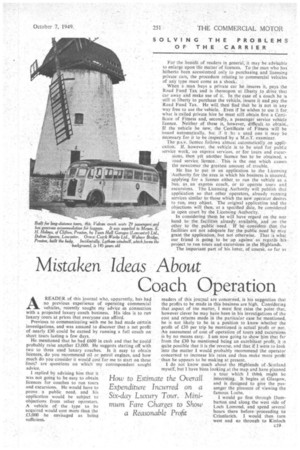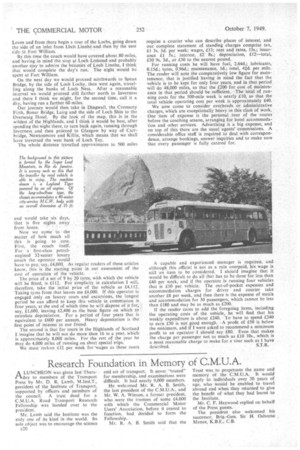Mistaken Ideas About Coach Operation
Page 57

Page 58

If you've noticed an error in this article please click here to report it so we can fix it.
AREADER of this journal who, apparently, has had no previous experience of operating commercial vehicles, recently sought my advice in connection with a projected luxury coach business. His idea is to run luxury tours at prices that everyone can affOrd.
Previous to communicating with me he had made certain investigations, and was amazed to discover that a net profit of nearly 130 could be earned by running a full coach on short tours lasting a few days.
He mentioned that he had £600 in cash and that he could probably raise another £3,000. He suggests starting of with two to three used luxury coaches. Is it easy to obtain licences, do you recommend oil or petrol engines, and how much do you consider it would cost for me to start on these lines? are questions on which my correspondent sought advice. , I replied by advising him that it was not going to be easy to obtain licences for coaches to run tours and excursions. He would have to prove a public need, and his application would be subject to objections from other operators. A vehicle of the type to be acquired would cost more than the £3,000 he envisaged as being sufficient, For the benefit of readers in general, it may be advisable to enlarge upon the matter of licences,. To the man who has hitherto been accustomed only to purchasing and licensing private cars, the procedure relating to commercial vehicles of any type must come as a shock.
When a man buys a private car he insures it, pays the Road Fund Tax and is thereupon at liberty to drive that car away and make use of it. In the case of a coach he is still at liberty to purchase the vehicle, insure it and pay the Road Fund Tax. He will then find that he is not in any way free to use the vehicle. Even if he wishes to use it for. what is called private hire he must still obtain first a Certificate of Fitness and, secondly, a passenger service vehicle licence. Neither of these is, however, difficult to obtain. If the vehicle be new, the Certificate of Fitness will he issued automatically, but if it bc a used one it may be necessary for it to be inspected by a M.o.T. examiner.
The p.s.v. licence follows almost automatically on application. If. however, the vehicle is to be used Tor public service work, on express services, or for tours and excursions, then yet another licence has to be obtained, a road service licence. This is the one which causes the newcomer the greatest amount of trouble.
He has to put in an application to..the Licensing -Authority for the area in Which his business is situated, applying for a licence either to run the vehicle as a bus, as, an express coach, or to operate tours and excursions. The Licensing Authority will publish that application so that other operators, already running services similar to those which the new operator desires to run, may object. The original application and the objections will then, at a specified date, he considered
in open court by the Licensing Authority. '
In considering them he will have regard on the one
hand . the facilities already -available, and on the other to the public need. 1€ he considers that the facilities are not adequate for the public .need he my grant the application, but not otherwise. That is what our friend is going to be up against as regards :his project to run tours and•excursions in the Highlands.
The important part of his letter, of course, so far as
readers of this jour,nal are concerned, is his suggestion that the profits to be made in this business are high. Considering that Aspect of the matter, I must first raise the point that, however clever he may have been in his investigations of the cost and returns made in the particular case he mentioned, he is not likely to be in a position to know whether the profit of £30 per trip he mentioned is actual profit or not An assessment of cost of operation of tours and excursions is by no means easy. I am now going to show him that far from the £30 he mentioned being an exorbitant profit, it is quite possible that it is the reverse, and that if I were to look into the matter I would probably recommend the operator concerned to increase his rates and thus make more profit than he appears to be making at present.
I do not know much about the Highlands of .Scotland myself, but I have been looking at the map and have planned a tour 'which I think might be interesting. It begins at Glasgow, and is designed to give the passenger the pleasure of viewing the famous Lochs.
I would go first through Dumbarton and along the west side of Loch Lomond, and spend several hours there before proceeding to Crianlarich. I would then turn west and go through to Kinloch
Leven and from there begin a tour of the Lochs, going down the side of an inlet from Lbch Linnhe-and then by the east side to Fort William.
By this time the coach would have covered about 80 miles, and having in mind the stop at Loch Lomond and probably another stay to admire the beauties of Loch Linnhe, I think. that would complete the day's run. The night would be spent at Fort William.
On the next day we would proceed nOrthwards to Sp,ean Bridge, by the side of Loch Lochy, then west again, travelling along the banks of Loch Ness. After a reasonable interval we would proceed still farther north to Inverness and there I think we might, for the second time, call it a day, having run a further 60 miles.
Our journey would then take in Dingwall, the Cromarty Firth, Bonar Bridge, Lairg and the side of Loch Shin to the Overscaig Hotel. By the look of the map, this is in the wildest of the Highlands, and I think it would be best, after spending the night there, to turn back again, running through Inverness. and then proceed to Glasgow by way of Carrbridge, Newtonmore and Killin, which means that we shall have traversed the west bank of Loch Tay.
The whole distance travelled approximates to 500 miles and would take six days, that is five nights away from home. • Now we corte to • the matter of hay much all this is going to cost. First, the coach itself. For a first-class petrolengined 32-seater luxury coach the operator would have to pay, say, £4,000. As regular readers of these articles know, this is the starting point in our assessment of the cost of operation of the vehicle. • The price of a set of 9 by 20 tyres, with which the vehicle will be fitted, is £112. For simplicity in calculation I will, therefore, take the initial price of the vehicle as £4,112. Taking tyres from that leaves me £4,000. If this operator is engaged only on luxury tours and excursions, the longest period he can afford to keep this vehicle in commission is four years, at the end of which time he will dispose of it for, say, £1,600, leaving £2,400 as the basic figure on which to calculate depreciation. For a period of four years that is equivalent to £600 per annum. Heavy depreciation is the first point of interest to our friend.
The second is that for tours in the Highlands of Scotland I imagine that he will not do more than 16 in a year, which is approximately 8,000 miles. For the rest of the year he may do 4,000 rifles of running on short special trips.
We must reckon £12 per week for -wages as these tours
requise a courier who can describe places of interest, and our complete statement of standing charges comprise tax, £1 3s. 3d per week; wages, £13; rent and rates, 13s.; insur ance 5s.; interest, . £2 8s.; depreciation, £12—totah £30 9s. 3d., or £30 to the nearest pound.
For running costs he will have fuel, 2.64d.; lubricants, 0.15d.; tyres, 0.96d.; maintenance, Id.; total, 414.1. per mile. The reader will note the comparatively low figure for maintenance; that is justified having in mind the fact that the vehicle is to be kept for only four years, and in that period will do 48,000 miles, so that the £200 for cost of maintenance in that period should be sufficient. The total of running costs for the 500-mile week is nearly £10, so that the total vehicle operating cost per week is approximately £40.
We now come to consider overheads or administrative charges, which are exceptionally heavy in this class of work. One item of expense is the personal tour of the -routes before the coaching season, arranging for hotel accommodation and other services. Advertising is a big expense, and on top of this there are the usual agents' commissions. A considerable office staff is required to deal with correspondence, arrange bookings, answer inquiries and to make sure that every passenger is fully catered for.
A capable and experiencedmanager is required, and although this official is -not as a rule overpaid, his wage is still an item to be considered. I should imagine that it would be difficult to do all that has to be done for less than £40 per week, and if the operator is running four vehicles that is £10 per vehicle. The out-of-pocket expenses and accommodation charges for driver and courier take another £8 per week, and then there is the expense of meals and accommodation for 30 passengers, which cannot be less than £180 and may be as much as £700.
If the reader cares to add the foregoing items, including the operating costs of the vehicle, he will find that his weekly expenditure is about £240. To have to spend £240 to earn £30 is not good enough. A profit of £50 is below the minimum, and if I were asked to recommend a minimum profit to an operatori should say £80. Eventhat makes the charge per passenger not as much as £10 10s., which is a most reasonable charge to make for a tour such as I have described. S.T.R.




































































































